-
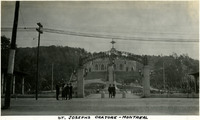 McCarthy Album 09, Photograph 131
McCarthy Album 09, Photograph 131 Caption: "St. Josephs Oratore [sic] - Montreal," c. 1925. William and Grace McCarthy beneath the entry arch to the complex containing St. Joseph's Oratory, a Roman Catholic basilica and shrine. Work on the building began in 1924, and continued until 1967. Only the first level of the building had been completed when this photograph was taken.
-
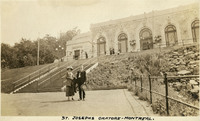 McCarthy Album 09, Photograph 130
McCarthy Album 09, Photograph 130 Caption: "St. Josephs Oratore [sic] - Montreal.," c. 1925. Unidentified man and Grace McCarthy pose in front of the St. Joseph's Oratory in Montreal, a Roman Catholic basilica and shrine. Work on the building began in 1924, and continued until 1967. Only the first level of the building had been completed when this photograph was taken.
-
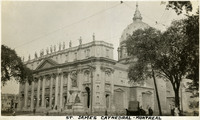 McCarthy Album 09, Photograph 129
McCarthy Album 09, Photograph 129 Caption: "St. James Cathedral - Montreal," c. 1925. The St. James Cathedral in Montreal was consecrated in 1894. At that time, it was the largest church in Quebec. Pope Pious XII rededicated the church in 1955 to Mary, Queen of the World. See also 96-07-08-alb04-092.
-
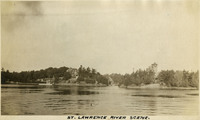 McCarthy Album 09, Photograph 128
McCarthy Album 09, Photograph 128 Caption: "St. Lawrence River Scene," c. 1925. This photograph looks across the Saint Lawrence River toward two large houses on the far bank. One of the houses may be on a small island.
-
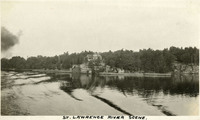 McCarthy Album 09, Photograph 127
McCarthy Album 09, Photograph 127 Caption: "St. Lawrence River Scene," c. 1925. This photograph looks across the Saint Lawrence River toward a large house and wooded area on the far bank.
-
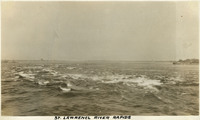 McCarthy Album 09, Photograph 126
McCarthy Album 09, Photograph 126 Caption: "St. Lawrence River Rapids," c. 1925. View of white caps on the Saint Lawrence River. This river is part of the international boundary between Ontario, Canada, and New York, U.S.A.
-
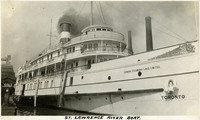 McCarthy Album 09, Photograph 125
McCarthy Album 09, Photograph 125 Caption: "St. Lawrence River Boat," c. 1925. A single stack steamship of the Canada Steamship Lines Limited on the St. Lawrence River.
-
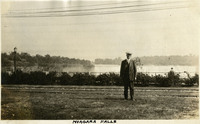 McCarthy Album 09, Photograph 124
McCarthy Album 09, Photograph 124 Caption: "Niagara Falls, c. 1925. William McCarthy poses in front of American Falls and Bridal Veil Falls, two of the three waterfalls that make up the iconic Niagara Falls straddling the border between Ontario, Canada, and the State of New York.
-
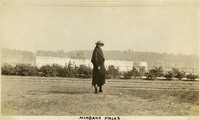 McCarthy Album 09, Photograph 123
McCarthy Album 09, Photograph 123 Caption: "Niagara Falls," c. 1925. Grace McCarthy poses in front of American Falls and Bridal Veil Falls, two of the three waterfalls that make up the iconic Niagara Falls straddling the border between Ontario, Canada, and the State of New York.
-
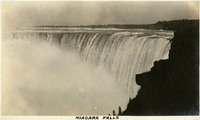 McCarthy Album 09, Photograph 122
McCarthy Album 09, Photograph 122 Caption: "Niagara Falls," c. 1925. View of Horseshoe Falls, the largest of the three waterfalls that make up the iconic Niagara Falls straddling the border between Ontario, Canada, and the State of New York.
-
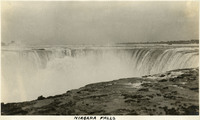 McCarthy Album 09, Photograph 121
McCarthy Album 09, Photograph 121 Caption: "Niagara Falls," c. 1925. View of Horseshoe Falls, the largest of the three waterfalls that make up the iconic Niagara Falls straddling the border between Ontario, Canada, and the State of New York.
-
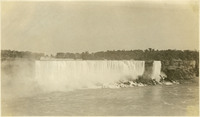 McCarthy Album 09, Photograph 120
McCarthy Album 09, Photograph 120 No caption. c. 1925. View of the American Falls (widest waterfall in the photograph), and Bridal Veil Falls, two of the three waterfalls that make up the iconic Niagara Falls straddling the border between Ontario, Canada, and the State of New York.
-
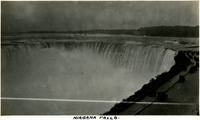 McCarthy Album 09, Photograph 119
McCarthy Album 09, Photograph 119 Caption: "Niagara Falls," c. 1925. View of Horseshoe Falls, largest of the three waterfalls that make up the iconic Niagara Falls straddling the border between Ontario, Canada, and the State of New York. At the right side of the photograph is a parking area with groups of tourists taking in the view.
-
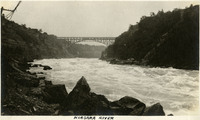 McCarthy Album 09, Photograph 118
McCarthy Album 09, Photograph 118 Caption: "Niagara River," c. 1925. The Whirlpool Rapids Bridge can be seen in this view of the Niagara River. The two-deck arch bridge, opened in 1897, connects the towns of Niagara Falls, Ontario, Canada, and Niagara Falls, New York.
-
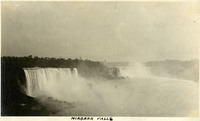 McCarthy Album 09, Photograph 117
McCarthy Album 09, Photograph 117 Caption: "Niagara Falls," c. 1925. View of the three waterfalls that make up the iconic Niagara Falls straddling the border between Ontario, Canada, and the State of New York. From left to right, the falls are called American Falls, Bridal Veil Falls (the smallest of the three), and Horseshoe Falls.
-
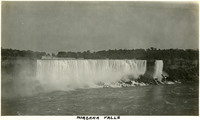 McCarthy Album 09, Photograph 116
McCarthy Album 09, Photograph 116 Caption: "Niagara Falls," c. 1925. View of the American Falls (widest waterfall in the photograph), and Bridal Veil Falls, two of the three waterfalls that make up the iconic Niagara Falls straddling the border between Ontario, Canada, and the State of New York.
-
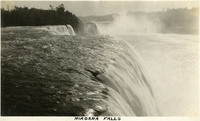 McCarthy Album 09, Photograph 115
McCarthy Album 09, Photograph 115 Caption: "Niagara Falls," c. 1925. View of the three waterfalls that make up the iconic Niagara Falls straddling the border between Ontario, Canada, and the State of New York. From near distance to far distance, the falls are called American Falls, Bridal Veil Falls (the smallest of the three), and Horseshoe Falls.
-
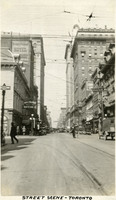 McCarthy Album 09, Photograph 114
McCarthy Album 09, Photograph 114 Caption: "Street Scene - Toronto," c. 1925. A bustling scene on an unidentified street in Toronto, Ontario.
-
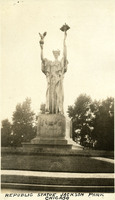 McCarthy Album 09, Photograph 113
McCarthy Album 09, Photograph 113 Caption: "Republic Statue Jackson Park Chicago," c. 1925. Designed by Chester French (sculptor), this version of the Statue of the Republic has stood in Chicago's Jackson Park since its construction in 1918. It is a one-third replica of a statue at the World's Columbian Exposition, held at Chicago in 1893.
-
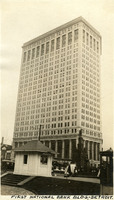 McCarthy Album 09, Photograph 112
McCarthy Album 09, Photograph 112 Caption: "First National Bank Bldg. - Detroit," c. 1925. When this building, designed by architect Albert Kahn in the Neoclassical style, was completed in 1922, it was Detroit's tallest structure. This photograph was taken before construction in 1926-27 of a twenty-five story addition adjacent to the building in this photograph.
-
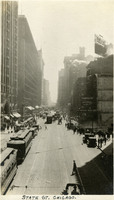 McCarthy Album 09, Photograph 111
McCarthy Album 09, Photograph 111 Caption: "State St. Chicago.," c. 1925. A busy street scene with people, cars and trollies.
-
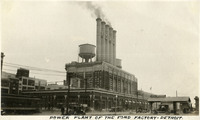 McCarthy Album 09, Photograph 110
McCarthy Album 09, Photograph 110 Caption: "Power Plant of the Ford Factory - Detroit," c. 1925. View of the power house at Ford's Highland Park Plant (considered to be the birthplace of the industrial assembly line). The plant's five smoke stacks have a "FORD" sign across them, flanked by two water towers.
-
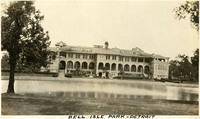 McCarthy Album 09, Photograph 109
McCarthy Album 09, Photograph 109 Caption: "Bell [sic] Isle Park - Detroit," c.1925. This photograph features the Belle Isle Casino, on the edge of Lake Tacoma on Belle Isle, in the Detroit River. The building is the second structure at the site, built in 1908 to replace a dilapidated wooden structure. The building is not a gambling facility, but is instead called a "casino" in the older sense of the word: a public building for meetings, dancing, reunions, and other recreation.
-
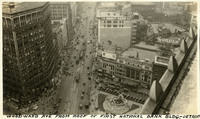 McCarthy Album 09, Photograph 108
McCarthy Album 09, Photograph 108 Caption: "Woodward Ave From Roof of First National Bank Bldg. - Detroit," c. 1925. Bird's eye view of a bustling street scene along Detroit's Woodward Ave.
-
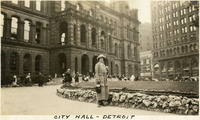 McCarthy Album 09, Photograph 107
McCarthy Album 09, Photograph 107 Caption: "City Hall - Detroit," c. 1925. Grace McCarthy poses in front of Detroit's City Hall. The Italian Renaissance Revival-style building, designed by architect James Anderson, was constructed between 1867 and 1871. It housed Detroit's city government until 1955, when a new facility was ready for occupation. This building was subsequently demolished in 1961.
-
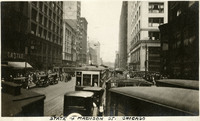 McCarthy Album 09, Photograph 106
McCarthy Album 09, Photograph 106 Caption: "State & Madison St. Chicago," c. 1923. A busy street scene at the intersection of State and Madison Streets in Chicago.
-
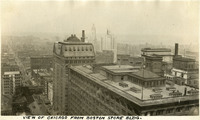 McCarthy Album 09, Photograph 105
McCarthy Album 09, Photograph 105 Caption: "View of Chicago From Boston Store Bldg," c. 1923. State Street, the Chicago Theatre, and the Wrigley Building (still under construction) can be seen in this bird's eye view of Chicago.
-
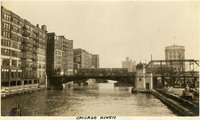 McCarthy Album 09, Photograph 104
McCarthy Album 09, Photograph 104 Caption: "Chicago River," c. 1923. A train crosses Michigan Avenue Bridge over the Chicago River in this photograph. The bascule bridge, engineered by the Chicago Department of Public Works, Bureau of Engineering, opened to traffic in 1920.
-
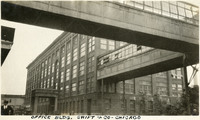 McCarthy Album 09, Photograph 103
McCarthy Album 09, Photograph 103 Caption: "Office Bldg. Swift & Co - Chicago," c. 1923. The general office of Chicago's Swift and Co., founded by meat packing magnate Gustavus Franklin Smith, Sr. in the late nineteenth century.
-
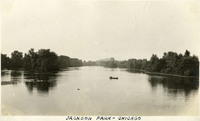 McCarthy Album 09, Photograph 102
McCarthy Album 09, Photograph 102 Caption: "Jackson Park - Chicago," c. 1923. The Grand Basin at Jackson Park. This 500-acre park was originally designed for use as the site of the World's Columbian Exposition (also called the Chicago World's Fair), held in 1893. The Grand Basin was a large reflecting pool at the center of the Exposition, around which the main buildings were constructed.
-
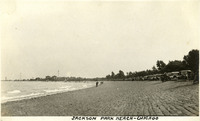 McCarthy Album 09, Photograph 101
McCarthy Album 09, Photograph 101 Caption: "Jackson Park Beach - Chicago," c. 1923. Jackson Park Beach at Lake Michigan, with a line of automobiles parked along the adjacent roadway.
-
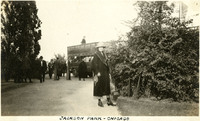 McCarthy Album 09, Photograph 100
McCarthy Album 09, Photograph 100 Caption: "Jackson Park - Chicago," c. 1923. Grace McCarthy poses for a photograph in Jackson Park while people behind her board a double decker bus.
-
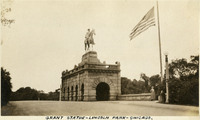 McCarthy Album 09, Photograph 099
McCarthy Album 09, Photograph 099 Caption: "Grant Statue - Lincoln Park - Chicago," c. 1923. Installed in 1891, the Ulysses S. Grant Memorial, created by Louis Rebisso (sculptor), is located in the east end of Chicago's Lincoln Park Zoo. It commemorates Ulysses S. Grant, former U.S. Army General and 18th President of the U.S.
-
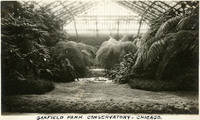 McCarthy Album 09, Photograph 098
McCarthy Album 09, Photograph 098 Caption: "Garfield Park Conservatory - Chicago," c. 1925. Construction began on the Garfield Park Conservatory in 1906. Opened to the public in 1908, the Conservatory is one of the largest greenhouse conservatories in the United States.
-
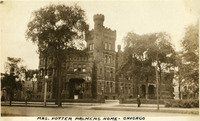 McCarthy Album 09, Photograph 097
McCarthy Album 09, Photograph 097 Caption: "Mrs. Potter Palmers [sic] Home - Chicago," c. 1923. Constructed between 1882-1885, Palmer Mansion was once the largest private residence in Chicago. It was demolished in 1950.
-
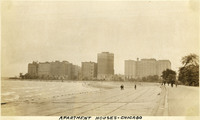 McCarthy Album 09, Photograph 096
McCarthy Album 09, Photograph 096 Caption: "Apartment Houses - Chicago," c. 1923. Apartment buildings near the shores of Lake Michigan.
-
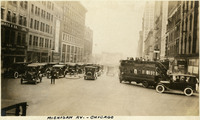 McCarthy Album 09, Photograph 095
McCarthy Album 09, Photograph 095 Caption: "Michigan AV. - Chicago," c. 1923. Michigan Avenue filled with cars, a double decker bus, and a traffic officer.
-
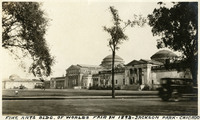 McCarthy Album 09, Photograph 094
McCarthy Album 09, Photograph 094 Caption: "Fine Arts Bldg. of Worlds Fair in 1893 - Jackson Park - Chicago," c. 1923. The Palace of Fine Arts building shown in this photograph was originally constructed for the World's Columbian Exposition held in Chicago in 1893. After the fair's completion, the building housed the Columbian Museum, which eventually became the Field Museum of Natural History. In 1920, that museum moved to a new building, and the Palace of Fine Arts building was left vacant. After renovations in the late 1920s, the Museum of Science and Industry opened at the site.
-
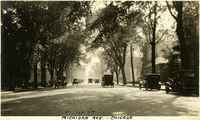 McCarthy Album 09, Photograph 093
McCarthy Album 09, Photograph 093 Caption: "Michigan Ave. - Chicago," c. 1923. A tree- lined Michigan Avenue filled with cars.
-
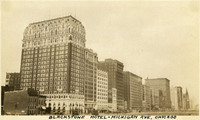 McCarthy Album 09, Photograph 092
McCarthy Album 09, Photograph 092 Caption: "Blackstone Hotel - Michigan Ave. Chicago," c. 1923. Built in 1909 and designed by Benjamin Marshall, the twenty-one story Blackstone Hotel sits on the corner of Michigan Avenue and Balbo Drive in Chicago Illinois. It is the building closest to the left side of the photograph in this row of high-rises. See also 96-07-08-alb04-074.
-
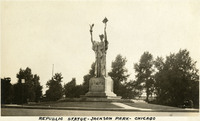 McCarthy Album 09, Photograph 091
McCarthy Album 09, Photograph 091 Caption: "Republic Statue - Jackson Park - Chicago," c. 1923. Designed by Chester French (sculptor), this version of the Statue of the Republic has stood in Chicago's Jackson Park since its construction in 1918. It is a one-third replica of a statue at the World's Columbian Exposition, held at Chicago in 1893.
-
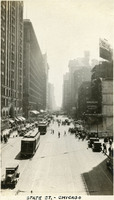 McCarthy Album 09, Photograph 090
McCarthy Album 09, Photograph 090 Caption: "State St. - Chicago," c. 1923. A busy street scene with people, automobiles, and trollies.
-
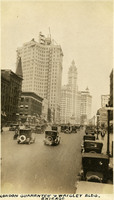 McCarthy Album 09, Photograph 089
McCarthy Album 09, Photograph 089 Caption: "London Guarantee & Wrigley Bldg. Chicago," c. 1923. This photograph, taken at street level, features the London Guarantee Building (with the small cupola still under construction at its top) and the Wrigley Building (just to the right of the London Guarantee Building). The London Guarantee Building (also called the London Guaranty and Accident Building), designed by Alfred S. Alschuler, was completed in 1923. The Wrigley Building, constructed by the famous chewing gum magnate William Wrigley, Jr., consists of two towers. The south tower was completed in 1921, while the north tower was finished in 1924 (you can make out construction scaffolding on the top of the tower in this photograph).
-
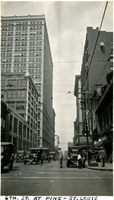 McCarthy Album 09, Photograph 088
McCarthy Album 09, Photograph 088 Caption: "6th. St. At Pine - St. Louis," c. 1923. A bustling street scene on 6th Street in St. Louis, at its intersection with Pine.
-
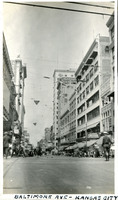 McCarthy Album 09, Photograph 087
McCarthy Album 09, Photograph 087 Caption: "Baltimore Ave - Kansas City," c. 1923. A busy street scene on Baltimore Ave in Kansas City.
-
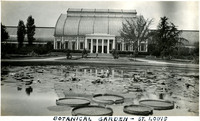 McCarthy Album 09, Photograph 086
McCarthy Album 09, Photograph 086 Caption: "Botanical Garden - St. Louis," c. 1923. View of the Palm House, built in 1915 to house tropical plants in the Missouri Botanical Gardens in St. Louis. It was torn down in 1959 to make room for the domed geodesic Climatron building which still stands at the site. See also 96-07-08-alb04-091.
-
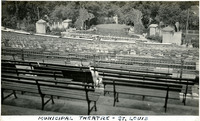 McCarthy Album 09, Photograph 085
McCarthy Album 09, Photograph 085 Caption: "Municipal Theatre - St. Louis," c. 1923. Built in 1917, the St. Louis Municipal Opera Theatre was the first municipally-owned outdoor theatre in the United States. The amphitheater seats 11,000 people, and is still in use today.
-
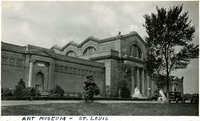 McCarthy Album 09, Photograph 084
McCarthy Album 09, Photograph 084 Caption: Art Museum - St. Louis," c. 1923. The Saint Louis Art Museum features elements of the Greek Revival style. It began life as the Palace of Fine Arts for the World's Fair held in St. Louis in 1904. The museum moved into the building after the fair's completion.
-
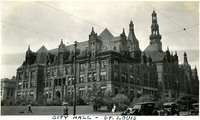 McCarthy Album 09, Photograph 083
McCarthy Album 09, Photograph 083 Caption: "City Hall - St. Louis," c. 1923. Grace McCarthy poses in front of the St. Louis City Hall, while a man mows the lawn and an adult and child stroll on the sidewalk. The French Renaissance Revival style building, designed by George Richard Mann, has been home to the city's governmental offices since 1898.
-
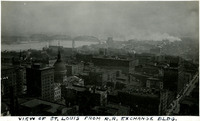 McCarthy Album 09, Photograph 082
McCarthy Album 09, Photograph 082 Caption: "View of St. Louis from R.R. Exchange Bldg," c. 1923. Merchant's Bridge and the Old Courthouse (domed building just to left of center) can be seen in this bird's eye view of St. Louis.
 McCarthy Album 09, Photograph 131 Caption: "St. Josephs Oratore [sic] - Montreal," c. 1925. William and Grace McCarthy beneath the entry arch to the complex containing St. Joseph's Oratory, a Roman Catholic basilica and shrine. Work on the building began in 1924, and continued until 1967. Only the first level of the building had been completed when this photograph was taken.
McCarthy Album 09, Photograph 131 Caption: "St. Josephs Oratore [sic] - Montreal," c. 1925. William and Grace McCarthy beneath the entry arch to the complex containing St. Joseph's Oratory, a Roman Catholic basilica and shrine. Work on the building began in 1924, and continued until 1967. Only the first level of the building had been completed when this photograph was taken. McCarthy Album 09, Photograph 130 Caption: "St. Josephs Oratore [sic] - Montreal.," c. 1925. Unidentified man and Grace McCarthy pose in front of the St. Joseph's Oratory in Montreal, a Roman Catholic basilica and shrine. Work on the building began in 1924, and continued until 1967. Only the first level of the building had been completed when this photograph was taken.
McCarthy Album 09, Photograph 130 Caption: "St. Josephs Oratore [sic] - Montreal.," c. 1925. Unidentified man and Grace McCarthy pose in front of the St. Joseph's Oratory in Montreal, a Roman Catholic basilica and shrine. Work on the building began in 1924, and continued until 1967. Only the first level of the building had been completed when this photograph was taken. McCarthy Album 09, Photograph 129 Caption: "St. James Cathedral - Montreal," c. 1925. The St. James Cathedral in Montreal was consecrated in 1894. At that time, it was the largest church in Quebec. Pope Pious XII rededicated the church in 1955 to Mary, Queen of the World. See also 96-07-08-alb04-092.
McCarthy Album 09, Photograph 129 Caption: "St. James Cathedral - Montreal," c. 1925. The St. James Cathedral in Montreal was consecrated in 1894. At that time, it was the largest church in Quebec. Pope Pious XII rededicated the church in 1955 to Mary, Queen of the World. See also 96-07-08-alb04-092. McCarthy Album 09, Photograph 128 Caption: "St. Lawrence River Scene," c. 1925. This photograph looks across the Saint Lawrence River toward two large houses on the far bank. One of the houses may be on a small island.
McCarthy Album 09, Photograph 128 Caption: "St. Lawrence River Scene," c. 1925. This photograph looks across the Saint Lawrence River toward two large houses on the far bank. One of the houses may be on a small island. McCarthy Album 09, Photograph 127 Caption: "St. Lawrence River Scene," c. 1925. This photograph looks across the Saint Lawrence River toward a large house and wooded area on the far bank.
McCarthy Album 09, Photograph 127 Caption: "St. Lawrence River Scene," c. 1925. This photograph looks across the Saint Lawrence River toward a large house and wooded area on the far bank. McCarthy Album 09, Photograph 126 Caption: "St. Lawrence River Rapids," c. 1925. View of white caps on the Saint Lawrence River. This river is part of the international boundary between Ontario, Canada, and New York, U.S.A.
McCarthy Album 09, Photograph 126 Caption: "St. Lawrence River Rapids," c. 1925. View of white caps on the Saint Lawrence River. This river is part of the international boundary between Ontario, Canada, and New York, U.S.A. McCarthy Album 09, Photograph 125 Caption: "St. Lawrence River Boat," c. 1925. A single stack steamship of the Canada Steamship Lines Limited on the St. Lawrence River.
McCarthy Album 09, Photograph 125 Caption: "St. Lawrence River Boat," c. 1925. A single stack steamship of the Canada Steamship Lines Limited on the St. Lawrence River. McCarthy Album 09, Photograph 124 Caption: "Niagara Falls, c. 1925. William McCarthy poses in front of American Falls and Bridal Veil Falls, two of the three waterfalls that make up the iconic Niagara Falls straddling the border between Ontario, Canada, and the State of New York.
McCarthy Album 09, Photograph 124 Caption: "Niagara Falls, c. 1925. William McCarthy poses in front of American Falls and Bridal Veil Falls, two of the three waterfalls that make up the iconic Niagara Falls straddling the border between Ontario, Canada, and the State of New York. McCarthy Album 09, Photograph 123 Caption: "Niagara Falls," c. 1925. Grace McCarthy poses in front of American Falls and Bridal Veil Falls, two of the three waterfalls that make up the iconic Niagara Falls straddling the border between Ontario, Canada, and the State of New York.
McCarthy Album 09, Photograph 123 Caption: "Niagara Falls," c. 1925. Grace McCarthy poses in front of American Falls and Bridal Veil Falls, two of the three waterfalls that make up the iconic Niagara Falls straddling the border between Ontario, Canada, and the State of New York. McCarthy Album 09, Photograph 122 Caption: "Niagara Falls," c. 1925. View of Horseshoe Falls, the largest of the three waterfalls that make up the iconic Niagara Falls straddling the border between Ontario, Canada, and the State of New York.
McCarthy Album 09, Photograph 122 Caption: "Niagara Falls," c. 1925. View of Horseshoe Falls, the largest of the three waterfalls that make up the iconic Niagara Falls straddling the border between Ontario, Canada, and the State of New York. McCarthy Album 09, Photograph 121 Caption: "Niagara Falls," c. 1925. View of Horseshoe Falls, the largest of the three waterfalls that make up the iconic Niagara Falls straddling the border between Ontario, Canada, and the State of New York.
McCarthy Album 09, Photograph 121 Caption: "Niagara Falls," c. 1925. View of Horseshoe Falls, the largest of the three waterfalls that make up the iconic Niagara Falls straddling the border between Ontario, Canada, and the State of New York. McCarthy Album 09, Photograph 120 No caption. c. 1925. View of the American Falls (widest waterfall in the photograph), and Bridal Veil Falls, two of the three waterfalls that make up the iconic Niagara Falls straddling the border between Ontario, Canada, and the State of New York.
McCarthy Album 09, Photograph 120 No caption. c. 1925. View of the American Falls (widest waterfall in the photograph), and Bridal Veil Falls, two of the three waterfalls that make up the iconic Niagara Falls straddling the border between Ontario, Canada, and the State of New York. McCarthy Album 09, Photograph 119 Caption: "Niagara Falls," c. 1925. View of Horseshoe Falls, largest of the three waterfalls that make up the iconic Niagara Falls straddling the border between Ontario, Canada, and the State of New York. At the right side of the photograph is a parking area with groups of tourists taking in the view.
McCarthy Album 09, Photograph 119 Caption: "Niagara Falls," c. 1925. View of Horseshoe Falls, largest of the three waterfalls that make up the iconic Niagara Falls straddling the border between Ontario, Canada, and the State of New York. At the right side of the photograph is a parking area with groups of tourists taking in the view. McCarthy Album 09, Photograph 118 Caption: "Niagara River," c. 1925. The Whirlpool Rapids Bridge can be seen in this view of the Niagara River. The two-deck arch bridge, opened in 1897, connects the towns of Niagara Falls, Ontario, Canada, and Niagara Falls, New York.
McCarthy Album 09, Photograph 118 Caption: "Niagara River," c. 1925. The Whirlpool Rapids Bridge can be seen in this view of the Niagara River. The two-deck arch bridge, opened in 1897, connects the towns of Niagara Falls, Ontario, Canada, and Niagara Falls, New York. McCarthy Album 09, Photograph 117 Caption: "Niagara Falls," c. 1925. View of the three waterfalls that make up the iconic Niagara Falls straddling the border between Ontario, Canada, and the State of New York. From left to right, the falls are called American Falls, Bridal Veil Falls (the smallest of the three), and Horseshoe Falls.
McCarthy Album 09, Photograph 117 Caption: "Niagara Falls," c. 1925. View of the three waterfalls that make up the iconic Niagara Falls straddling the border between Ontario, Canada, and the State of New York. From left to right, the falls are called American Falls, Bridal Veil Falls (the smallest of the three), and Horseshoe Falls. McCarthy Album 09, Photograph 116 Caption: "Niagara Falls," c. 1925. View of the American Falls (widest waterfall in the photograph), and Bridal Veil Falls, two of the three waterfalls that make up the iconic Niagara Falls straddling the border between Ontario, Canada, and the State of New York.
McCarthy Album 09, Photograph 116 Caption: "Niagara Falls," c. 1925. View of the American Falls (widest waterfall in the photograph), and Bridal Veil Falls, two of the three waterfalls that make up the iconic Niagara Falls straddling the border between Ontario, Canada, and the State of New York. McCarthy Album 09, Photograph 115 Caption: "Niagara Falls," c. 1925. View of the three waterfalls that make up the iconic Niagara Falls straddling the border between Ontario, Canada, and the State of New York. From near distance to far distance, the falls are called American Falls, Bridal Veil Falls (the smallest of the three), and Horseshoe Falls.
McCarthy Album 09, Photograph 115 Caption: "Niagara Falls," c. 1925. View of the three waterfalls that make up the iconic Niagara Falls straddling the border between Ontario, Canada, and the State of New York. From near distance to far distance, the falls are called American Falls, Bridal Veil Falls (the smallest of the three), and Horseshoe Falls. McCarthy Album 09, Photograph 114 Caption: "Street Scene - Toronto," c. 1925. A bustling scene on an unidentified street in Toronto, Ontario.
McCarthy Album 09, Photograph 114 Caption: "Street Scene - Toronto," c. 1925. A bustling scene on an unidentified street in Toronto, Ontario. McCarthy Album 09, Photograph 113 Caption: "Republic Statue Jackson Park Chicago," c. 1925. Designed by Chester French (sculptor), this version of the Statue of the Republic has stood in Chicago's Jackson Park since its construction in 1918. It is a one-third replica of a statue at the World's Columbian Exposition, held at Chicago in 1893.
McCarthy Album 09, Photograph 113 Caption: "Republic Statue Jackson Park Chicago," c. 1925. Designed by Chester French (sculptor), this version of the Statue of the Republic has stood in Chicago's Jackson Park since its construction in 1918. It is a one-third replica of a statue at the World's Columbian Exposition, held at Chicago in 1893. McCarthy Album 09, Photograph 112 Caption: "First National Bank Bldg. - Detroit," c. 1925. When this building, designed by architect Albert Kahn in the Neoclassical style, was completed in 1922, it was Detroit's tallest structure. This photograph was taken before construction in 1926-27 of a twenty-five story addition adjacent to the building in this photograph.
McCarthy Album 09, Photograph 112 Caption: "First National Bank Bldg. - Detroit," c. 1925. When this building, designed by architect Albert Kahn in the Neoclassical style, was completed in 1922, it was Detroit's tallest structure. This photograph was taken before construction in 1926-27 of a twenty-five story addition adjacent to the building in this photograph. McCarthy Album 09, Photograph 111 Caption: "State St. Chicago.," c. 1925. A busy street scene with people, cars and trollies.
McCarthy Album 09, Photograph 111 Caption: "State St. Chicago.," c. 1925. A busy street scene with people, cars and trollies. McCarthy Album 09, Photograph 110 Caption: "Power Plant of the Ford Factory - Detroit," c. 1925. View of the power house at Ford's Highland Park Plant (considered to be the birthplace of the industrial assembly line). The plant's five smoke stacks have a "FORD" sign across them, flanked by two water towers.
McCarthy Album 09, Photograph 110 Caption: "Power Plant of the Ford Factory - Detroit," c. 1925. View of the power house at Ford's Highland Park Plant (considered to be the birthplace of the industrial assembly line). The plant's five smoke stacks have a "FORD" sign across them, flanked by two water towers. McCarthy Album 09, Photograph 109 Caption: "Bell [sic] Isle Park - Detroit," c.1925. This photograph features the Belle Isle Casino, on the edge of Lake Tacoma on Belle Isle, in the Detroit River. The building is the second structure at the site, built in 1908 to replace a dilapidated wooden structure. The building is not a gambling facility, but is instead called a "casino" in the older sense of the word: a public building for meetings, dancing, reunions, and other recreation.
McCarthy Album 09, Photograph 109 Caption: "Bell [sic] Isle Park - Detroit," c.1925. This photograph features the Belle Isle Casino, on the edge of Lake Tacoma on Belle Isle, in the Detroit River. The building is the second structure at the site, built in 1908 to replace a dilapidated wooden structure. The building is not a gambling facility, but is instead called a "casino" in the older sense of the word: a public building for meetings, dancing, reunions, and other recreation. McCarthy Album 09, Photograph 108 Caption: "Woodward Ave From Roof of First National Bank Bldg. - Detroit," c. 1925. Bird's eye view of a bustling street scene along Detroit's Woodward Ave.
McCarthy Album 09, Photograph 108 Caption: "Woodward Ave From Roof of First National Bank Bldg. - Detroit," c. 1925. Bird's eye view of a bustling street scene along Detroit's Woodward Ave. McCarthy Album 09, Photograph 107 Caption: "City Hall - Detroit," c. 1925. Grace McCarthy poses in front of Detroit's City Hall. The Italian Renaissance Revival-style building, designed by architect James Anderson, was constructed between 1867 and 1871. It housed Detroit's city government until 1955, when a new facility was ready for occupation. This building was subsequently demolished in 1961.
McCarthy Album 09, Photograph 107 Caption: "City Hall - Detroit," c. 1925. Grace McCarthy poses in front of Detroit's City Hall. The Italian Renaissance Revival-style building, designed by architect James Anderson, was constructed between 1867 and 1871. It housed Detroit's city government until 1955, when a new facility was ready for occupation. This building was subsequently demolished in 1961. McCarthy Album 09, Photograph 106 Caption: "State & Madison St. Chicago," c. 1923. A busy street scene at the intersection of State and Madison Streets in Chicago.
McCarthy Album 09, Photograph 106 Caption: "State & Madison St. Chicago," c. 1923. A busy street scene at the intersection of State and Madison Streets in Chicago. McCarthy Album 09, Photograph 105 Caption: "View of Chicago From Boston Store Bldg," c. 1923. State Street, the Chicago Theatre, and the Wrigley Building (still under construction) can be seen in this bird's eye view of Chicago.
McCarthy Album 09, Photograph 105 Caption: "View of Chicago From Boston Store Bldg," c. 1923. State Street, the Chicago Theatre, and the Wrigley Building (still under construction) can be seen in this bird's eye view of Chicago. McCarthy Album 09, Photograph 104 Caption: "Chicago River," c. 1923. A train crosses Michigan Avenue Bridge over the Chicago River in this photograph. The bascule bridge, engineered by the Chicago Department of Public Works, Bureau of Engineering, opened to traffic in 1920.
McCarthy Album 09, Photograph 104 Caption: "Chicago River," c. 1923. A train crosses Michigan Avenue Bridge over the Chicago River in this photograph. The bascule bridge, engineered by the Chicago Department of Public Works, Bureau of Engineering, opened to traffic in 1920. McCarthy Album 09, Photograph 103 Caption: "Office Bldg. Swift & Co - Chicago," c. 1923. The general office of Chicago's Swift and Co., founded by meat packing magnate Gustavus Franklin Smith, Sr. in the late nineteenth century.
McCarthy Album 09, Photograph 103 Caption: "Office Bldg. Swift & Co - Chicago," c. 1923. The general office of Chicago's Swift and Co., founded by meat packing magnate Gustavus Franklin Smith, Sr. in the late nineteenth century. McCarthy Album 09, Photograph 102 Caption: "Jackson Park - Chicago," c. 1923. The Grand Basin at Jackson Park. This 500-acre park was originally designed for use as the site of the World's Columbian Exposition (also called the Chicago World's Fair), held in 1893. The Grand Basin was a large reflecting pool at the center of the Exposition, around which the main buildings were constructed.
McCarthy Album 09, Photograph 102 Caption: "Jackson Park - Chicago," c. 1923. The Grand Basin at Jackson Park. This 500-acre park was originally designed for use as the site of the World's Columbian Exposition (also called the Chicago World's Fair), held in 1893. The Grand Basin was a large reflecting pool at the center of the Exposition, around which the main buildings were constructed. McCarthy Album 09, Photograph 101 Caption: "Jackson Park Beach - Chicago," c. 1923. Jackson Park Beach at Lake Michigan, with a line of automobiles parked along the adjacent roadway.
McCarthy Album 09, Photograph 101 Caption: "Jackson Park Beach - Chicago," c. 1923. Jackson Park Beach at Lake Michigan, with a line of automobiles parked along the adjacent roadway. McCarthy Album 09, Photograph 100 Caption: "Jackson Park - Chicago," c. 1923. Grace McCarthy poses for a photograph in Jackson Park while people behind her board a double decker bus.
McCarthy Album 09, Photograph 100 Caption: "Jackson Park - Chicago," c. 1923. Grace McCarthy poses for a photograph in Jackson Park while people behind her board a double decker bus. McCarthy Album 09, Photograph 099 Caption: "Grant Statue - Lincoln Park - Chicago," c. 1923. Installed in 1891, the Ulysses S. Grant Memorial, created by Louis Rebisso (sculptor), is located in the east end of Chicago's Lincoln Park Zoo. It commemorates Ulysses S. Grant, former U.S. Army General and 18th President of the U.S.
McCarthy Album 09, Photograph 099 Caption: "Grant Statue - Lincoln Park - Chicago," c. 1923. Installed in 1891, the Ulysses S. Grant Memorial, created by Louis Rebisso (sculptor), is located in the east end of Chicago's Lincoln Park Zoo. It commemorates Ulysses S. Grant, former U.S. Army General and 18th President of the U.S. McCarthy Album 09, Photograph 098 Caption: "Garfield Park Conservatory - Chicago," c. 1925. Construction began on the Garfield Park Conservatory in 1906. Opened to the public in 1908, the Conservatory is one of the largest greenhouse conservatories in the United States.
McCarthy Album 09, Photograph 098 Caption: "Garfield Park Conservatory - Chicago," c. 1925. Construction began on the Garfield Park Conservatory in 1906. Opened to the public in 1908, the Conservatory is one of the largest greenhouse conservatories in the United States. McCarthy Album 09, Photograph 097 Caption: "Mrs. Potter Palmers [sic] Home - Chicago," c. 1923. Constructed between 1882-1885, Palmer Mansion was once the largest private residence in Chicago. It was demolished in 1950.
McCarthy Album 09, Photograph 097 Caption: "Mrs. Potter Palmers [sic] Home - Chicago," c. 1923. Constructed between 1882-1885, Palmer Mansion was once the largest private residence in Chicago. It was demolished in 1950. McCarthy Album 09, Photograph 096 Caption: "Apartment Houses - Chicago," c. 1923. Apartment buildings near the shores of Lake Michigan.
McCarthy Album 09, Photograph 096 Caption: "Apartment Houses - Chicago," c. 1923. Apartment buildings near the shores of Lake Michigan. McCarthy Album 09, Photograph 095 Caption: "Michigan AV. - Chicago," c. 1923. Michigan Avenue filled with cars, a double decker bus, and a traffic officer.
McCarthy Album 09, Photograph 095 Caption: "Michigan AV. - Chicago," c. 1923. Michigan Avenue filled with cars, a double decker bus, and a traffic officer. McCarthy Album 09, Photograph 094 Caption: "Fine Arts Bldg. of Worlds Fair in 1893 - Jackson Park - Chicago," c. 1923. The Palace of Fine Arts building shown in this photograph was originally constructed for the World's Columbian Exposition held in Chicago in 1893. After the fair's completion, the building housed the Columbian Museum, which eventually became the Field Museum of Natural History. In 1920, that museum moved to a new building, and the Palace of Fine Arts building was left vacant. After renovations in the late 1920s, the Museum of Science and Industry opened at the site.
McCarthy Album 09, Photograph 094 Caption: "Fine Arts Bldg. of Worlds Fair in 1893 - Jackson Park - Chicago," c. 1923. The Palace of Fine Arts building shown in this photograph was originally constructed for the World's Columbian Exposition held in Chicago in 1893. After the fair's completion, the building housed the Columbian Museum, which eventually became the Field Museum of Natural History. In 1920, that museum moved to a new building, and the Palace of Fine Arts building was left vacant. After renovations in the late 1920s, the Museum of Science and Industry opened at the site. McCarthy Album 09, Photograph 093 Caption: "Michigan Ave. - Chicago," c. 1923. A tree- lined Michigan Avenue filled with cars.
McCarthy Album 09, Photograph 093 Caption: "Michigan Ave. - Chicago," c. 1923. A tree- lined Michigan Avenue filled with cars. McCarthy Album 09, Photograph 092 Caption: "Blackstone Hotel - Michigan Ave. Chicago," c. 1923. Built in 1909 and designed by Benjamin Marshall, the twenty-one story Blackstone Hotel sits on the corner of Michigan Avenue and Balbo Drive in Chicago Illinois. It is the building closest to the left side of the photograph in this row of high-rises. See also 96-07-08-alb04-074.
McCarthy Album 09, Photograph 092 Caption: "Blackstone Hotel - Michigan Ave. Chicago," c. 1923. Built in 1909 and designed by Benjamin Marshall, the twenty-one story Blackstone Hotel sits on the corner of Michigan Avenue and Balbo Drive in Chicago Illinois. It is the building closest to the left side of the photograph in this row of high-rises. See also 96-07-08-alb04-074. McCarthy Album 09, Photograph 091 Caption: "Republic Statue - Jackson Park - Chicago," c. 1923. Designed by Chester French (sculptor), this version of the Statue of the Republic has stood in Chicago's Jackson Park since its construction in 1918. It is a one-third replica of a statue at the World's Columbian Exposition, held at Chicago in 1893.
McCarthy Album 09, Photograph 091 Caption: "Republic Statue - Jackson Park - Chicago," c. 1923. Designed by Chester French (sculptor), this version of the Statue of the Republic has stood in Chicago's Jackson Park since its construction in 1918. It is a one-third replica of a statue at the World's Columbian Exposition, held at Chicago in 1893. McCarthy Album 09, Photograph 090 Caption: "State St. - Chicago," c. 1923. A busy street scene with people, automobiles, and trollies.
McCarthy Album 09, Photograph 090 Caption: "State St. - Chicago," c. 1923. A busy street scene with people, automobiles, and trollies. McCarthy Album 09, Photograph 089 Caption: "London Guarantee & Wrigley Bldg. Chicago," c. 1923. This photograph, taken at street level, features the London Guarantee Building (with the small cupola still under construction at its top) and the Wrigley Building (just to the right of the London Guarantee Building). The London Guarantee Building (also called the London Guaranty and Accident Building), designed by Alfred S. Alschuler, was completed in 1923. The Wrigley Building, constructed by the famous chewing gum magnate William Wrigley, Jr., consists of two towers. The south tower was completed in 1921, while the north tower was finished in 1924 (you can make out construction scaffolding on the top of the tower in this photograph).
McCarthy Album 09, Photograph 089 Caption: "London Guarantee & Wrigley Bldg. Chicago," c. 1923. This photograph, taken at street level, features the London Guarantee Building (with the small cupola still under construction at its top) and the Wrigley Building (just to the right of the London Guarantee Building). The London Guarantee Building (also called the London Guaranty and Accident Building), designed by Alfred S. Alschuler, was completed in 1923. The Wrigley Building, constructed by the famous chewing gum magnate William Wrigley, Jr., consists of two towers. The south tower was completed in 1921, while the north tower was finished in 1924 (you can make out construction scaffolding on the top of the tower in this photograph). McCarthy Album 09, Photograph 088 Caption: "6th. St. At Pine - St. Louis," c. 1923. A bustling street scene on 6th Street in St. Louis, at its intersection with Pine.
McCarthy Album 09, Photograph 088 Caption: "6th. St. At Pine - St. Louis," c. 1923. A bustling street scene on 6th Street in St. Louis, at its intersection with Pine. McCarthy Album 09, Photograph 087 Caption: "Baltimore Ave - Kansas City," c. 1923. A busy street scene on Baltimore Ave in Kansas City.
McCarthy Album 09, Photograph 087 Caption: "Baltimore Ave - Kansas City," c. 1923. A busy street scene on Baltimore Ave in Kansas City. McCarthy Album 09, Photograph 086 Caption: "Botanical Garden - St. Louis," c. 1923. View of the Palm House, built in 1915 to house tropical plants in the Missouri Botanical Gardens in St. Louis. It was torn down in 1959 to make room for the domed geodesic Climatron building which still stands at the site. See also 96-07-08-alb04-091.
McCarthy Album 09, Photograph 086 Caption: "Botanical Garden - St. Louis," c. 1923. View of the Palm House, built in 1915 to house tropical plants in the Missouri Botanical Gardens in St. Louis. It was torn down in 1959 to make room for the domed geodesic Climatron building which still stands at the site. See also 96-07-08-alb04-091. McCarthy Album 09, Photograph 085 Caption: "Municipal Theatre - St. Louis," c. 1923. Built in 1917, the St. Louis Municipal Opera Theatre was the first municipally-owned outdoor theatre in the United States. The amphitheater seats 11,000 people, and is still in use today.
McCarthy Album 09, Photograph 085 Caption: "Municipal Theatre - St. Louis," c. 1923. Built in 1917, the St. Louis Municipal Opera Theatre was the first municipally-owned outdoor theatre in the United States. The amphitheater seats 11,000 people, and is still in use today. McCarthy Album 09, Photograph 084 Caption: Art Museum - St. Louis," c. 1923. The Saint Louis Art Museum features elements of the Greek Revival style. It began life as the Palace of Fine Arts for the World's Fair held in St. Louis in 1904. The museum moved into the building after the fair's completion.
McCarthy Album 09, Photograph 084 Caption: Art Museum - St. Louis," c. 1923. The Saint Louis Art Museum features elements of the Greek Revival style. It began life as the Palace of Fine Arts for the World's Fair held in St. Louis in 1904. The museum moved into the building after the fair's completion. McCarthy Album 09, Photograph 083 Caption: "City Hall - St. Louis," c. 1923. Grace McCarthy poses in front of the St. Louis City Hall, while a man mows the lawn and an adult and child stroll on the sidewalk. The French Renaissance Revival style building, designed by George Richard Mann, has been home to the city's governmental offices since 1898.
McCarthy Album 09, Photograph 083 Caption: "City Hall - St. Louis," c. 1923. Grace McCarthy poses in front of the St. Louis City Hall, while a man mows the lawn and an adult and child stroll on the sidewalk. The French Renaissance Revival style building, designed by George Richard Mann, has been home to the city's governmental offices since 1898. McCarthy Album 09, Photograph 082 Caption: "View of St. Louis from R.R. Exchange Bldg," c. 1923. Merchant's Bridge and the Old Courthouse (domed building just to left of center) can be seen in this bird's eye view of St. Louis.
McCarthy Album 09, Photograph 082 Caption: "View of St. Louis from R.R. Exchange Bldg," c. 1923. Merchant's Bridge and the Old Courthouse (domed building just to left of center) can be seen in this bird's eye view of St. Louis.